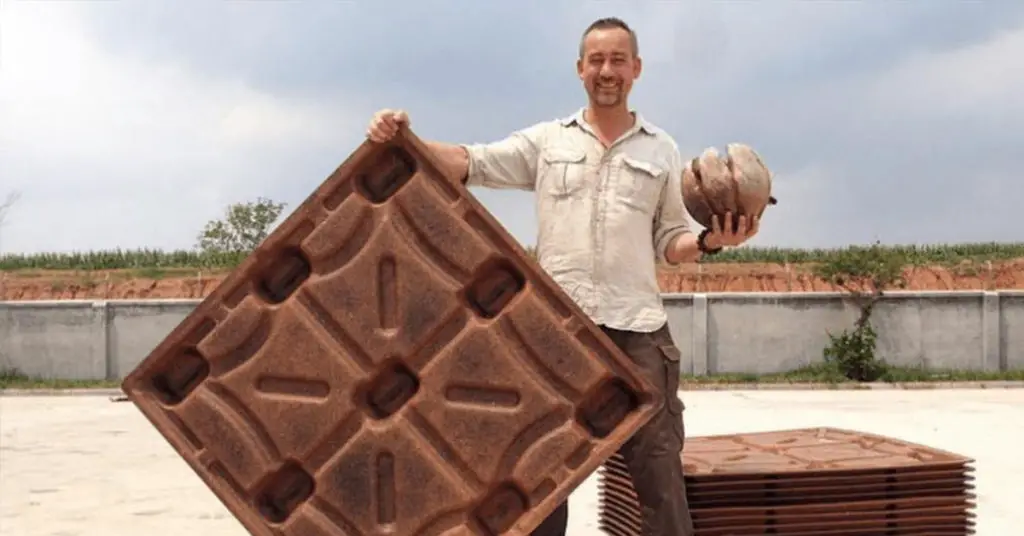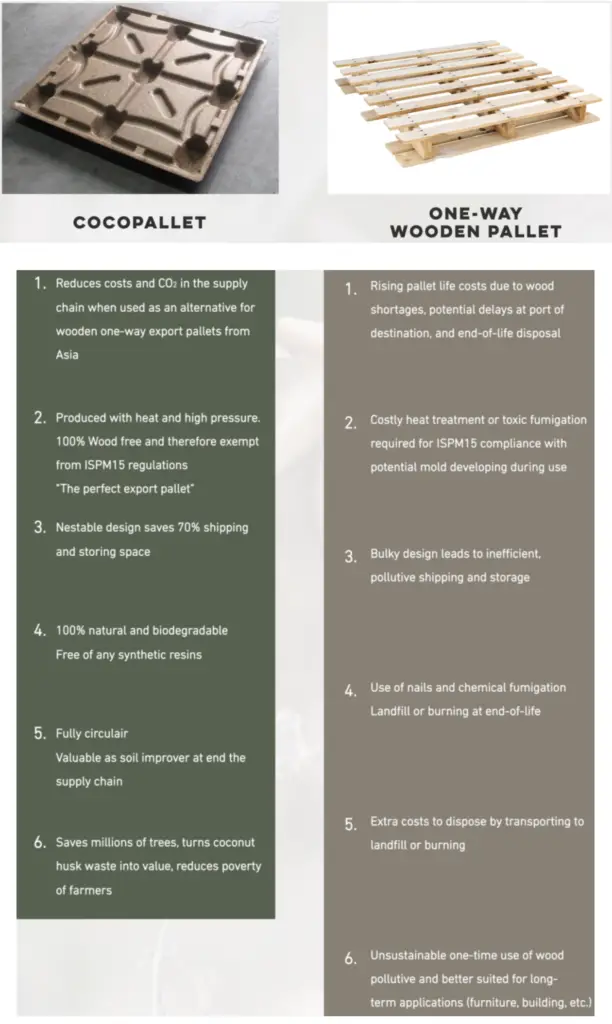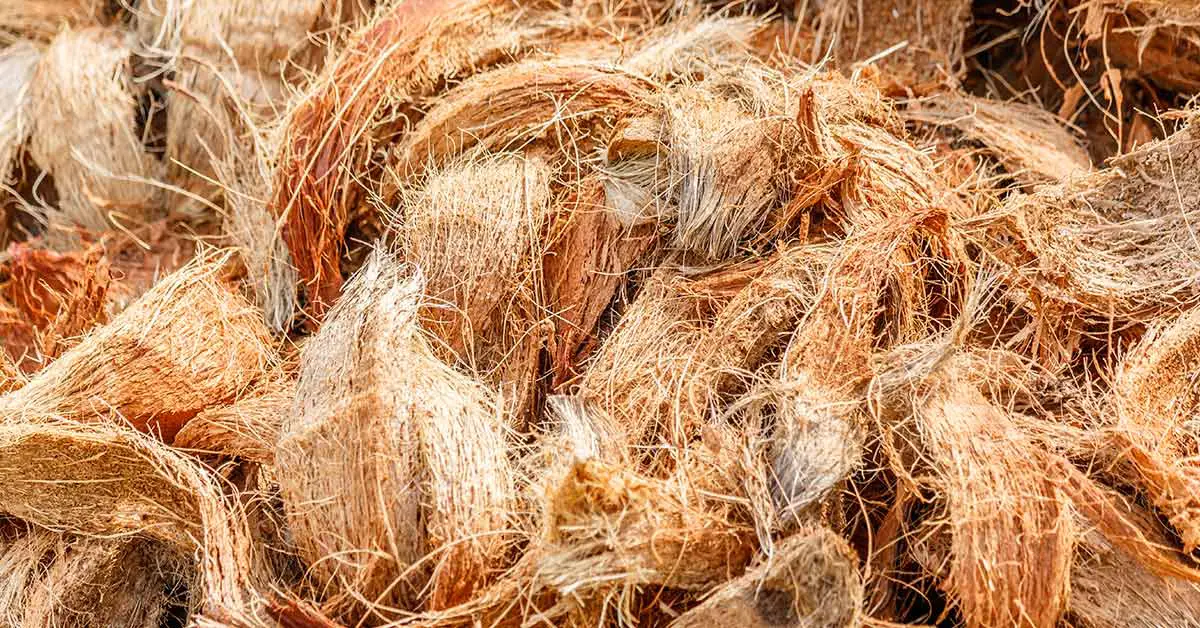There are approximately 3 trillion trees gracing this planet. That may sound a lot, but keep in mind that over 15 billion trees are chopped down every year. Plus, according to a study in the journal Nature, the worldwide number of trees had fallen by about 46% since the beginning of human civilization. [1] After all, wood is a vital material for various industries. We use it to build houses, furniture, paper, and many other goods. However, we must search for more sustainable alternatives to preserve the forests and trees that remain. Fortunately, a Dutch startup called CocoPallet is changing the game using coconut husks.
What is CocoPallet?
Instead of lumber, CocoPallet recycles coconut husk waste into 100% bio-based transportation pallets. Coconut trees grow in coastal areas all over the world. The husks, however, have yet to find a purpose aside from becoming trashed after the extraction of coconut oil. Until now.
These pallets are used in cargo transportation and are normally made of wood. However, the process to make these coconut husk pallets is cheaper than the one to make wooden ones. Plus, it doesn’t require the highly toxic methyl-bromide fumigation still used to manufacture wood pallets in some countries. Not only that, the coconut husks don’t require glue since the husk produces natural glue called lignin that’s activated when the pallets are pressed together in hot temperatures. Shipping pallets are used everywhere, so it’s no surprise that CocoPallet is estimated to save about 0.5 million trees a year.

Researchers at Wageningen University developed the method to create hardboard from coconut husk waste. Later on, this method became commercialized by Michiel Voz, the founder of CocoPallet. He teamed up with Jan Van Dam, a plant scientist from the university who specializes in using plant fiber to create various materials. He tried to manufacture the technique to turn coconut husk into hardboard in 2005 with little success.
“In many tropical countries, the coconut waste is rotting away or is set on fire,” said Van Dam. “If you make raw materials out of the husk, you will hit several birds with one stone: you prevent deforestation because less wood will be produced, you give farmers an extra income, because their waste is worth money, and you prevent the material from slowly rotting away, reducing pollution and climate change.”
Read: Company Is Using Plastic Bottles To Make Roads That Last 3x Longer Than Asphalt
Turning Coconut Husks into Pallets
Michiel Vos teamed up with Van Dom and revived the technique. As Vos explained, “Asia produces more than a billion pallets every year. They require softwood, which does not grow in the tropics, thus is imported from Canada, New Zealand, or Eastern Europe on a large scale. Complete forests are being shipped to Asia to make pallets that are mainly used to ship products back to America or Europe. It is clearly a lot more efficient to make them in Asia with local materials.”
Not only is this technique more sustainable and locally sourced, but pallets made from coconut husks have other advantages as well. Vos explained, “They are stronger and lighter than the old-fashioned pallets, they are fire retardant, and thanks to an adjusted design, also easier to stack, so they take up less space. Above all, they are cheaper, and a lower price is always the best sales argument for a sustainable product.” Additionally, the coconut version is more resistant to moisture and termites — which is vital for tropical climates. [2]
CocoPallet has won entrepreneurial and innovation awards. The startup’s headquarters are in Amsterdam, the Netherlands, and plans to open its first venture factory in the Philippines. [3]

Why Deforestation Matters
Why should people care about the dwindling number of trees? Well, deforestation affects the entire world, not just the people and animals where the trees are chopped. For instance, about 250 million people — many of them in poverty — live in forest and savannah areas and they depend on the environment for their income and survival. Additionally, deforestation threatens the plants and animal species that live there, including those endangered for extinction.
However, the negative effects are even further-reaching. For example, it could cause the loss of clean water and biodiversity. Additionally, cutting trees means more carbon dioxide in the air all over the globe. Fortunately, many organizations are working on ways to preserve the forests and increase tree numbers. Finding new and sustainable alternatives to wood, like coconut husks, is also vital for the success and longevity of this movement. [4]
Keep Reading: Denmark Is Repurposing Discarded Wind Turbine Blades as Bike Shelters
Sources
- “Mapping tree density at a global scale.” Nature. T. W. Crowther, H. B. Glick, M. A. Bradford.
- “Coconut husks are best alternatives to wood.” Science Times. Sieeka Khan.
- “FAQ” CocoPallet Website.
- “Deforestation explained.” National Geographic. Christina Nunez.

